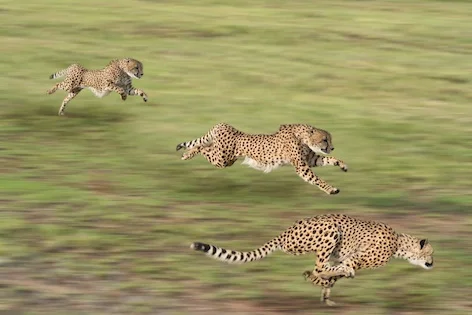The cheetah is a big cat.
It is the fastest runner of all animals.
Its body is built for speed.
Cheetahs live on the grasslands in Africa.
Cheetahs eat meat.
The cheetah's body is built for speed. ©Getty Images
What are cheetahs?
Cheetahs are big cats, the smallest of the big cat group.
A group of cheetahs is called a coalition of cheetahs.
Habitat and Distribution (where they are found)
Cheetahs live on the grasslands of eastern and southern Africa.
Body and Behaviours
Cheetahs have two lines running down each side of the face. ©Getty Images
Cheetahs have yellow fur with dark spots. Their faces have a dark line running from each eye to the corners of their mouth, often called 'tear lines' as though they'd been crying.
It is thought that this helps them see across the grasslands in the hot sunshine: the dark fur works like sunglasses to stop the glare.
Unlike other big cats, cheetahs do not roar, but make a chirping sound. They also purr, which they can do both breathing in and breathing out.
Resting cheetahs in a nature reserve ©kidcyber
Cheetahs are the fastest of all land animals
They sprint to chase their prey, usually small antelopes. At the start of a chase they run at 80 kilometres per hour, but they reach a speed of 112 kilometres per hour for a short distance. When running this fast, one full stride stretches over 7 metres long. The cheetah's front and back legs cross over, then the body stretches out into full stride and all four legs are off the ground.
At full speed cheetahs can change direction fast, often in mid air, when their prey does. Cheetahs don't maintain such speeds over great distances. After running so fast, a cheetah needs about half an hour to recover. It cannot defend itself when it is so tired after such a run, so other animals such as hyenas and lions can easily take its kill away from it.
At full speed there are moments when all four feet are off the ground. ©Getty
The cheetah hunts in daytime, but not during the middle part of the day when it is very hot. It shelters during the middle of the day to keep cool. Lions and other predators hunt at dawn and dusk, so the cheetah waits until they have finished hunting and have begun their rest.
Cheetahs generally live alone. Sometimes brothers from one litter may stay together when they are grown up, and then they hunt as a team and can chase bigger prey such as zebra.
Adaptations
A cheetah’s body has special features that help it run at such fast speeds. This is called adaptation. Its body is a streamlined shape, with long legs and small head that doesn’t cause wind resistance.
Its long tail helps it balance and steer.
All other cats can pull their claws in or push them out, but a cheetah’s claws are always out and help it grip the ground when it runs fast. Its foot pads have ridges to help it grip the ground when it is running, rather like a human's running shoe has.
The cheetah has large passages inside its nose to help it breathe while running fast. Their eyesight, particularly long distance eyesight, is exceptionally keen.
Because a cheetah depends on its speed to get food, even a small injury can mean it cannot hunt. A cheetah’s body is light and lean, so it has no stored body fat to help it survive when there is little food around.
Cheetahs don't climb trees, but do leap onto the lower branch of a tree instead. ©Getty Images
Life Cycle
Female cheetahs are always alone, except for when they have cubs. Sometimes males from a litter stay together.
A cheetah mother and cub ©Getty Images
Usually three or four cubs, sometimes more, are born in one litter. The mother must continue to eat so that she has enough milk to feed them, and so she must hide them and leave them for long periods while she hunts. She moves them to a new hiding place every few days to keep them safe.
When the cubs are six months old, the mother cheetah brings back small live animals so that the cubs can learn and practice how to chase prey. When they are a year old they start hunting and catching small animals by themselves, with some help from their mother. By the time they are two, the cubs move away and live by themselves.
Conservation Status and Threats
A young cheetah ©Getty Images
Cheetahs are classified as Vulnerable, which means their numbers are low.
Habitat loss is a serious threat, with people building homes and farms on the grasslands so there is less space for the cheetahs in the wild.
The survival rate of young cheetahs is low. Many cheetah cubs die because they have to be left alone for so long, which is dangerous for them. They can wander off and get lost, or may be killed by other animals such as lions. Cubs can die of starvation, for example if the mother is injured and unable to hunt, or if she is killed.
It’s a good idea to get your information from more than one source!
Read more about cheetahs, watch videos and listen to them purr!
https://cheetah.org/kids/cheetah-facts/








